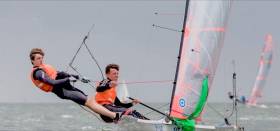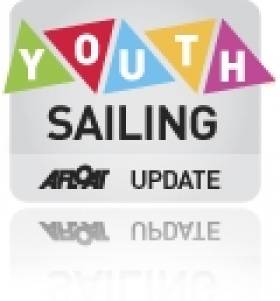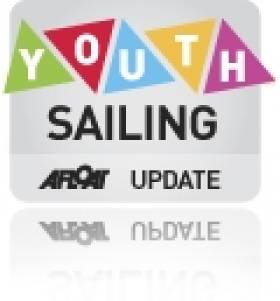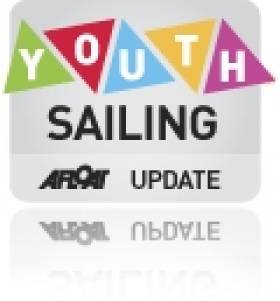Displaying items by tag: 29er
Royal Cork Youth Skiff Pair Win UK 29er Champs
Royal Cork's Harry Durcan and Harry Whittaker have won the UK 29er National Championship in Torbay. After six days racing and 19 races in all, it all came down to the final race which they secured with a bullet giving them a two point lead over the rest of the fleet. Full results here. Conditions today were shifty at best and the Race Officer did well to get four races in to finish the final series.
Just as Ireland named Finn Lynch as its last sailor for Rio yesterday, the final four sailors who will take to the water for Team GB at the Rio 2016 Olympic Games have were announced by the British Olympic Association (BOA).
Luke Patience and Chris Grube will compete in the men's 470, while Dylan Fletcher and Alain Sign complete the squad in the 49er after a close British selection battle.
For Fletcher, Sign and Grube, Rio 2016 will be their first Olympic outing, with Grube having teamed up with Patience following Elliot Willis's cancer diagnosis at the end of 2015. Patience already has an Olympic medal to his name - a 470 silver he picked up with Stuart Bithell at London 2012.
The first group of sailors was announced back in September with further names being added in March and today's announcement completes the 15-strong sailing line-up that will head to Rio 2016.
Team GB lead the way in sailing at the Olympic Games and sit atop the overall standings with 55 medals accrued since 1986 - including 26 golds.
The four sailors selected today are:
Luke Patience, 29 (Men's 470)
Chris Grube, 31 (Men's 470)
Dylan Fletcher, 28 (49er)
Alain Sign, 30 (49er)
Those previously selected are:
Giles Scott (Finn)
Nick Thompson (Laser)
Alison Young (Laser Radial)
Bryony Shaw (Women's RS:X)
Nick Dempsey (Men's RS:X)
Hannah Mills (Women's 470)
Saskia Clark (Women's 470)
Charlotte Dobson (49erFX)
Sophie Ainsworth (49erFX)
Ben Saxton (Nacra 17)
Nicola Groves (Nacra 17)
Crew wanted for 29er Worlds & Youth Worlds Campaign
After coming close to qualifying for the Youth Worlds in 2015, with only eight months in a 29er, Royal Cork youth sailor Harry Durcan is looking for a crew who wants to work towards competing at the front of the 29er fleet in European, World & Youth World Championships, with the ultimate goal being to medal at these events.
Durcan continues to train in the 29er with stand–in crews until he finds a permanent crew.
In a social media post this month, Durcan, a former top Optimist sailor, says his campaign comes complete with two competitive boats, a support Rib, training partners and a coach.
Ireland's ISAF Youth Worlds Team for Portugal Selected
#isafyouthworlds – It's an indication of the depth of current talent in Irish youth sailing that selection for this July's ISAF Youth Sailing World Championships came down to the last race of the youth championships in Howth this afternoon. The team of five boys and three girls will compete across three different classes in Portugal each one hoping to match Finn Lynch's stunning silver medal achieved in 2012.
Only one male and one female place were offered in each class and the contenders had to meet both international standards as well as win their category (except for the 29er) at the youth national championships to be selected. In the end sailors from Cork, Dublin and Belfast were winners and will race at Tavira, Portugal from the 12 – 19 July.
In the Laser Radial boys recent Laser Europa cup performer Séafra Guilfoyle (Royal Cork Yacht Club) will represent and Sarah Eames (Ballyholme Yacht Club) represents in the Laser Radial girls.
Robert Dickson and Sean Waddilove (Howth Yacht Club) who featured at last year's 420 Euros in Pwlhelli will race in the 420 boys, Lizzie and Cara McDowell (Malahide Yacht Club) in the 420 girls.
Recently fifth overall at the RYA youth championships in Weymouth skiff pairing Sean Donnelly (National Yacht Club) and Patrick Crosbie (Royal Cork Yacht Club) will race in the 29er open.
ISA Squad for the ISAF Youth Sailing World Championships 2014:
Laser Radial
Boy: Séafra Guilfoyle (Royal Cork Yacht Club)
Girl: Sarah Eames (Ballyholme Yacht Club)
420
Boys: Robert Dickson and Sean Waddilove (Howth Yacht Club)
Girls: Lizzie and Cara McDowell (Malahide Yacht Club)
29er
Open: Sean Donnelly (National Yacht Club) and Patrick Crosbie (Royal Cork Yacht Club)
#youthsailing – Sole Irish skiff duo Sean Donnelly and Patrick Crosbie took fifth overall in a highly competitive British youth nationals fleet in Weymouth yesterday. After eight races and one discard in the week long event, the National Yacht Club pairing counted seven top ten results, inlcuding a third place in race six in a 64–boat fleet.
And in the 420 dinghy, Ewan McMahon and Colin O'Sullivan from Malahide Yacht Club were 15th overall. Club mates Lizzie and Carrie McDowell were 26th in the 44–boat fleet.
ll classes took to the water as scheduled on this final day of racing yesterday but battled against a light shifty breeze resulting in postponements and abandonments across the four course areas. The RS:X were the only class to complete a race, whilst the other four classes attempted one race, which was abandoned shortly after starting.
The RS:X boys' class was the one to watch this week as the battle for the top spot was the hot topic of conversation on the final day of racing. Entering the final day of the regatta Daniel Wilson trailed overnight leader Robert York by two points, however was unable to overcome the deficit as York clinched a second in the only race of the day to take event victory.
"It feels pretty awesome, I have put in a lot of hard work over the week so it's nice for it to pay off," expressed the 18-year-old from Skegness.
"It means a lot, I have been in the RS:X for two years now. Last year was my first Youth Nationals and it didn't really go to plan so it's nice to win it this year. I have been looking up to people for a quite a few years so it's nice to finally be there."
York found himself in third place going up the first beat with Wilson leading the race from the word go. Fighting against the light breeze inside Portland Harbour, York managed to pull himself up into second, while Wilson dropped back into third, handing York his first RYA Youth Nationals title.
"The last race didn't start off too well, I had an okay start but probably didn't go the right way up the first beat and ended up in third. Then the wind started to drop, there was a lot of pumping involved but I managed to bring it back and get past Dan [Wilson] who finished third."
Imogen Sills has completed her quest in emulating older brother Sam and twin sister Saskia by winning her first RYA Youth Nationals title in the female RS:X windsurfing event. Sills sealed championships honours with a fourth place finish overall, ending her regatta an impressive 20 points ahead of second placed Emma Wilson.
"I've finally won a Youth Nationals title," laughed the17-year-old from Launceston. "It means a lot to win and I'm just so happy. I worked hard and knew what I had to do, it feels good to keep the title within the family."
Entering today's final races with a healthy lead, Sills admits that she still had a lot to do to secure the title: "Emma [Wilson] is pretty good in light winds, so I thought if there was two races then there was a chance that she could overtake me, so I had to stay near her and work hard and keep an eye out. I didn't think I had won before the race, I wasn't taking anything to chance."
The 420 boys class was won by 2013 Youth National champion Tim Riley and his new crew James Taylor, who finished fifth at the 2013 event in Largs, Scotland with his former sailing partner. The duo who had a disappointing start to the regatta, soon came into their own posting seven top three finishes from the 12 race series to win the regatta by a comfortable 17 points. Robbie King and Ryan Orr clinched the silver medal while New Zealand's Sam Barnett and Zak Merton finished with the bronze.
Riley said: "I am relieved mostly, it was such a long day on the water especially with all the wind shifting about and I was half hopeful they would get a race in. We got one away and we were doing quite well in it then they canned it because there was no wind. I looked at my watch and noticed the time limit was over and realised I'd won it, just relief, pure relief."
On defending his Youth National title, Riley added: "It means a lot to win it for a second year, especially this year as we have had so many young competitive sailors in the 420 class really coming up and just to be able to hold them off for one week which is a long, long time in these varying conditions is a relief."
Sarah Norbury and Mari Davies took the girls 420 title holding their place as top female crew throughout the regatta. At the halfway stage of the regatta the duo really upped their game and posted three seconds giving them a sizable lead over the other 420 girls crews and placing them an impress fourth overall. Jemima Lawson and Lily Summers won silver while Olivia Mackay and Abby Goodwin (NZL) finished third.
Norbury said: "It's incredible, it feels so good to win! All the work hard has paid off and it has all come together so we are really pleased."
For the 29er title, Owen Bowerman and Morgan Peach tussled all week with 2013 Youth National champion and 2013 29er World Championship silver medallist Marcus Somerville and his crew Isaac Mchardie for the top spot but fell short by a single point, giving the Kiwi sailors their second consecutive Youth National title.
"The Kiwi's put in some great competition this week so hats off to them, it has been awesome having them here! We also have had some great British people to race against so to finish second is a massive achievement for us. It's been hard work and I am pretty proud of what we have managed to achieve" said Bowerman.
Bowerman and Peach finished top GBR boat whilst Scotland's Gilles Munro and Daniel Harris rounded their regatta off with a hard fought bronze medal. Ruth Allan and Alice Masterman were the top placed female boat finishing seventh overall, improving on their 13th place finish at the 2013 event.
Scotland's Jamie Calder claimed his first RYA Youth Nationals title in Radial fleet which saw competition become extremely tight once the qualifying series determined the Gold fleet. Having posted a set of consistent scores in the qualifying series, Calder entered the final series at the top of the pack. Facing stiff competition in a competitive Radial fleet, the Scottish sailor kept his focus and continued an impressive scoreline to claim event honours.
Ellie Cumpsty claimed victory in the Radial female fleet by an impressive 38 points. Cumpsty finished eighth overall while New Zealand's Ali Nightingale finished second female with Rhiannon Massey laying in third.
Coming in as one of the favourites, Cumpsty confessed: "If I messed it up it would be pretty disappointing for me. I managed to stay calm and exceed my expectations."
The Spitfire class was a tight affair with Weymouth duo Sam Barker and Ross McFarline and Olivier Greber and Jess Eales swapping first and second place all week. Two race wins on the penultimate day of racing was enough to give Barker and McFarline the Youth National title, while Greber and Eales were made to settle for the Under 19 crown. Brothers Oliver and James King took bronze.
James Tilley, RYA Youth Nationals Event Manager, said: "It has been a fantastic week of racing at WPNSA, on the behalf of the RYA I would like to thank the huge team of volunteers, the venue and all of the sailors for making it an excellent event."
Double Olympic gold medallist Sarah Gosling OBE, who has formed part of the RYA's Selection Panel at WPNSA this week, added: "I have been really impressed with the standard of racing this week, it's fantastic to have some foreign sailors here. The boat handling around the course has been strong and in a wide range of conditions which has been fantastic especially from a selectors point of view to see how the sailors react to different conditions.
"For those who didn't quite achieve what they set out to, they need to remember it is the first stepping stone in their journey and I think everyone needs to understand that you don't necessarily win everything you set out to, you don't always perform to the best of your ability all the time.
"It is how you overcome that, take the lessons forward and improve for the next event and this is actually what makes a great sailor. Not everyone will win everything, it's how you knuckle down after this event and assess what happened then go out and do better next time," concluded Gosling.
Irish 29er Pair in Gold Fleet Position in Weymouth
#ryayouthweek – Irish 29er skiff sailors Sean Donnelly and Patrick Crosbie are through to the gold fleet of the RYA's Youth National Championships at Weymouth this week. The National Yacht Club pairing lie 17th in a fleet of 32 with gold fleet racing starting today on the 2012 Olympic waters. Results to date here.
Over 392 dinghy, catamaran and windsurf racers in the six youth classes will compete across four race course areas but only two Irish boats travelled to the RYA's premier youth event of the season. Five reigning champions will be bidding to retain their crowns.
Ireland's other participant is Howth Yacht Club's Ewan McMahon and Colin O'Sullivan who lie 19th from 44 after six races in the doublehanded 420 class. Results here.
Top 29er Skiff Result for Irish Dinghy Pair at Hayling Island
#29er – Irish 29er skiff pairing were fifth overall at the Zhik UK 2013 29er Class National & Open Championships at Hayling Island SC last week. Sean and Tadhg Donnelly of the National Yacht Club, who disappointed at the Cyprus ISAF Youth Worlds in July, were in top form on the UK south coast leading the 92–boat fleet after seven races. Results here
29er Brothers Racing in World Championship Gold Fleet
#29er – More than making amends for a disappointing second appearance at the ISAF Youth worlds a fortnight ago, the National Yacht Club Donnelly Brothers are through to the Gold fleet of the 29er 29er Skiff Worlds in Denmark today. Sean and Tadhg lie 26th this morning in a massive 216–boat fleet thus making the gold fleet cut.
Thunderstorms have interrupted racing, but the sole Irish team ,with coaching from London 2012s Matt McGovern, has put together a great series so far.
Results here
#dublinbay2012 – There will be host nation debuts in both the SL16 catamaran and 29er skiff classes at the 2012 Four Star Pizza ISAF Youth Worlds on Dublin Bay in ten days time.
Sean Donnelly and Tadgh Donnelly compete in the 29er and Alexander Rumball and Rory McStay go in the SL16 but as the championships is also set to welcome back 2011 gold medallists in both the SL16 and 29er the Irish crews have their work cut out.
Martin Lowy and Kim Andrade (BRA) head to Dublin to defend the SL16 title they comprehensively won in Zadar, Croatia last year whilst Spain's Carlos Robles and Florian Trittel (ESP) will be aiming to do the double.
The 15 strong SL16 fleet has the makings of an excellent competition with five of the six medallists at the 2011 ISAF Youth Worlds back again.
Lowy and Andrade blew the competition away in the light winds in Croatia that were prevalent at the start of the competition winning eight races in a row to set them up for the gold medal. When the big conditions came in the Brazilians finished mid-fleet as Danish twin brothers Nicolaj and Daniel Bjornholt Christiansen kicked it up a gear with four top two finishes.
The Danes comeback only proved enough for the silver medal as the Brazilians won by a seemingly comfortable margin of seven points.
The conditions in Ireland may suit the Bjornholt Christiansen's whose size will prove advantageous. Great Britain's Rupert White finished third with Nikola Boniface in 2011, he returns with Tom Britz.
In four years' time the Mixed Multihull will be on show at the Rio 2016 Olympic Sailing Competition following the selection of the Nacra 17. The Open SL16 event at this year's regatta features several mixed crews. Paul Darmanin and Lucy Copeland (AUS) are one of those in Dublin with Rio 2016 on their mind, "The mixed multihull for the Games is on our rader but I just want to focus on the Youth Worlds at the moment," said Darmanin who won SL16 gold in 2010 as crew with Chase Lurati.
"My cousin Jason and sister Lisa are training very hard working towards the 2016 Games so for me to try for the Olympics I would have to battle it out against them.
"Competing at the Olympic Games would be the ultimate dream come true as it is the highest level of sailing around. I love representing Australia so doing it at the Olympics would be fantastic."
New Zealand's Tomer Simhony finished fifth at the 2011 ISAF Youth Worlds in the SL16 with Ellie Copeland and is back again with another female crew, Gemma Jones. And the pair have considered their futures, "I think they [ISAF] made the right choice with the Nacra 17," said Simhony. "Gemma and I have discussed sailing together and will at least try to get a boat in the next two years and start a campaign. We'll see how it goes."
Twenty six teams will compete for 29er gold but the undermining favourites coming into the event are the 2011 Champions Carlos Robles and Florian Trittel (ESP). The Spaniards stormed to gold in Zadar, Croatia with a string of consistent results over 12 races to claim gold by 18 points.
With only Klaus Lange and Mateo Majdalani (ARG) returning from the top ten finishers in 2011, the Spaniards will aim for a second successive gold. Other returnees from 2011 include Paul Kohlhoff and Carolina Werner (GER), Varun Thakkar and Ganapathy Kelapanda (IND), as well as Alex Burger and Alex Lehtinen (RSA).
The fleet features a new wave of young sailors who will be seen beyond 2012 with 43 of the 52 sailors competing in the 26-boat fleet eligible to sail at the 2013 edition in Limassol, Cyprus. Belgium's Emile Van Holsbeke will be the youngest competitor in the 29er fleet at just 14-years-old. He will crew alongside Daan Vandormael.
Racing at the 2012 Four Star Pizza ISAF Youth Sailing World Championship begins on 14 July in Dun, Laoghaire, Ireland running until 20 July.
Youth Boat Selection Requires Leadership
There has been a call for the Irish Sailing Association (ISA) to take a lead in the big decisions that face youth sailors on what classes to sail to after they leave the ranks of the Optimist, Topper and Feva classes. The call comes from a leading junior organiser who does not wish to be named.
Although youth sailing is buoyant in Ireland it is known there is a 'high attrition rate' among teenagers. The lack of transfer in to senior dinghy classes has been a cause of concern for many clubs around the country.
The comments follow a recently published article on Afloat.ie promoting the RS 200 dinghy as a progression boat for juniors.
"We need a class that will keep youths engaged. The 420 and 29er are great boats but require higher levels of boathandling, are much more competitive and tend to attract the top sailors"
"While the ISA's Olympic ambitions are great to see, it will fail the sport as a whole if it does not tackle this gaping need, the organiser says.
Read the RS 200 article by Ciara Byrne and the junior organiser's comments here






































































